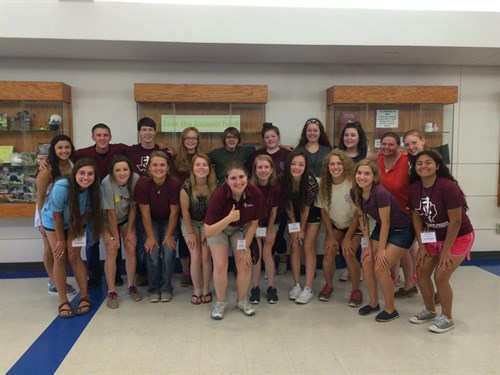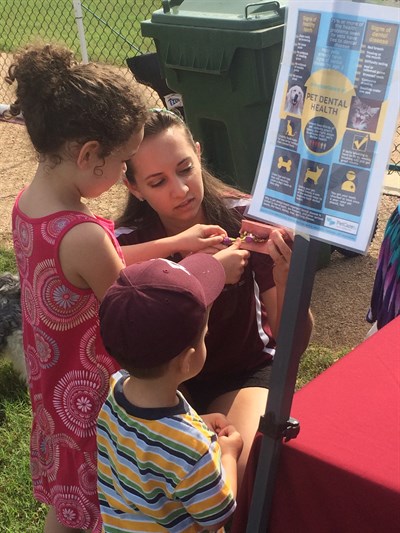PEER to Peer: Inspiring Children through Veterinary Medicine
At the College of Veterinary Medicine & Biomedical Sciences (CVM), education goes beyond just teaching students how to be veterinarians. Through the Partnership for Environmental Education and Rural Health (PEER) program, veterinary students, undergraduate biomedical science students, faculty, and staff work together to educate and inspire a love of science in K–12 students.


PEER uses demonstrations and lessons from the field of veterinary medicine to introduce children, mainly middle school-aged, to a variety of scientific concepts. “Kids love animals, so we use the information about animals to stimulate their interest. For example, we have a presentation on a physical exam,” said Dr. Larry Johnson, professor at the CVM who runs PEER. “They can learn the vital signs, such as heart rate and respiratory rate, of their favorite animal. You know they’re going to memorize those, and they’re going to discover they’ve got vital signs too.”
Tori Whitaker, a content specialist with PEER, echoed this and said, “It’s not easy to talk about obesity with middle school students, which is why we try to relate issues such as diabetes and obesity to pets. Our work really fits nicely into the One Health Initiative, the link between human and animal health and the environment, and that’s a lot of fun.”
Many of the presentations, videos, and lesson plans are generated by students, veterinarians, faculty, and staff at Texas A&M. “We have brilliant students who want to come up with something to share,” Johnson said. “We try to make the presentations about whatever they like—for example, if they like cows, we try to get them to do a lesson on cows—because the students are more passionate about what they like. Some students have said that they get a chance to refresh their memory about the things they’ve learned and see it in a different context.”
In the summer, veterinary students travel to various schools and other sites to present lessons to middle school children. Not only do the children learn about science, but the veterinary students also learn how to teach and interact with children. “Our veterinary students have a vast scope of knowledge, but not all of them have had the opportunity to be in a classroom or interact with the community in this way, so I may go out with the first couple of students and give them hints and pointers,” Whitaker said.
Clarissa Root, a third-year veterinary student involved in PEER said, “I have really enjoyed teaching and getting to help mentor students. When I saw that PEER had opportunities available for veterinary students to do that sort of work, I was excited about it.”
In addition to veterinary students, undergraduates throughout Texas A&M work and create learning materials at PEER. Students from a variety of majors each contribute their unique knowledge and perspectives that develop into a wealth of lesson plans and presentations. “The undergraduates work with the middle school students and interact with the other groups that want to be involved in developing presentations,” Johnson said. “Again, we give them an opportunity to do something they enjoy, and they do something that advances our program too.”


Each lesson plan is carefully aligned with the state’s educational standards, and the students who develop these presentations are guided through the PEER program. “Our students develop curriculum for teachers,” Whitaker said. “Teachers can write in to our website and request a lesson on pretty much anything. Then, the students can develop the lesson. I help the students make sure that the lesson they’re creating is applicable to the Texas State standards, the education standards, which are the TEKS, the Texas Essential Knowledge and Skills. We make sure that we don’t give a teacher a lesson that isn’t usable.”
Presentations can take a variety of forms, and one example is panel presentations. PEER has hosted a panel of veterinary students who discussed their journey to veterinary school. “The panel went through different personal histories of how they were admitted into veterinary school,” Johnson said. “For example, one veterinary student said that her dog had an infection and the veterinarian was using one antibiotic. The dog wasn’t getting better, and so she read there was another antibiotic that might work in that case. She asked the veterinarian about it, and they started using it and cured the infection. It was then that the student realized that she really enjoyed the problem solving involved in veterinary medicine.”
PEER also develops a number of videos available to students, veterinarians, and educators year round. “The nice thing about having videos and a website is that anyone can have access to them throughout the year, even when veterinary students aren’t available to give presentations in person,” Root said.
The impact of PEER’s work is mutual between the audience they serve and those who work for PEER. “I love the outreach,” Whitaker said. “I love getting out with the students either in a classroom or at the museums or libraries and just seeing how excited they get about the application of science.”
“I definitely enjoy getting to work with the students and seeing them grasp new concepts and have those ‘light bulb’ moments of understanding concepts. I also like seeing them feel empowered to become veterinarians and to hear their questions,” Root said. “It’s always gratifying if I run into one of them again, after our initial contact, and they’re still on the pathway to veterinary school. They might remember a presentation I gave or remember asking me questions. I enjoy making a difference in helping them pursue their dreams.”
Looking ahead, PEER is developing a program that partners teachers and scientists and will allow teachers to shadow and train with scientists from the CVM for several weeks. The teachers can then take that knowledge back to their students. “We are going to put in a proposal that pairs scientists and veterinarians with teachers to come up with an experiment that they would use whenever they describe the scientific method to their kids,” Johnson said.
PEER is also investigating other cutting-edge learning methods, including flipped classrooms that focus on student-centered learning and making their content accessible on mobile devices. But, no matter where the future takes PEER, the group plans to continue to enrich the lives of students, teachers, and many others.


